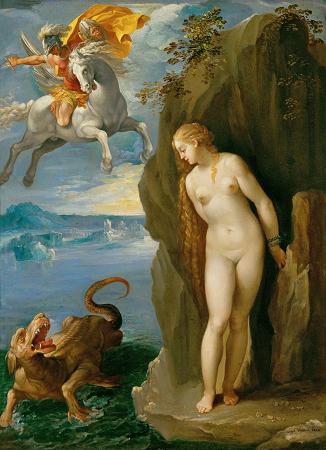Andromeda. Andromeda is the daughter of King Cepheus and Queen Cassiopeia. She is often shown naked or semi-naked, with her hands chained above her head to a rock, for example in Andromeda by Peter Rubens at the Gemaldsgalere, Berlin. Many artists have depicted the moment when Perseus, flying with his winged sandals, sees Andromeda and falls in love with her. He then proceeds to slay the sea monster and free her. Sometimes, Andromeda is shown with her parents, Cepheus and Cassiopeia. This usually occurs in scenes leading up to her sacrifice, where Cassiopeia's boast about her daughter's beauty leads to the wrath of the sea god Poseidon. Andromeda is sometimes shown after her rescue, often in the company of Perseus. When Cassiopeia's hubris leads her to boast that Andromeda is more beautiful than the Nereids, Poseidon sends the sea monster Cetus to ravage Andromeda as divine punishment. Andromeda is chained to a rock as a sacrifice to sate the monster, but is saved from death by Perseus. Her name is the Latinized form of the Greek or: ruler of men, from man, and I protect, rule over. As a subject, Andromeda has been popular in art since classical times; it is one of several Greek myths of a Greek hero's rescue of the intended victim of an archaic hieros gamos, giving rise to the princess and dragon motif. From the Renaissance, interest revived in the original story, typically as derived from Ovid's account. In Greek mythology, Andromeda was the daughter of Cepheus and Cassiopeia, king and queen of the African kingdom of Aethiopia. Her mother Cassiopeia boasted that she was more beautiful than the Nereids, the nymph-daughters of the sea god Nereus and often seen accompanying Poseidon. To punish the queen for her arrogance, Poseidon, brother to Zeus and god of the sea, sent a sea monster named Cetus to ravage the coast of Aethiopia including the kingdom of the vain queen. The desperate king consulted the Oracle of Apollo, who announced that no respite would be found until the king sacrificed his daughter, Andromeda, to the monster. She was then chained to a rock on the coast. Perseus was returning from having slain the Gorgon, Medusa. Seeing Andromeda bound to the rock awaiting death, Perseus fell in love with her. After he happened upon the chained Andromeda, he held up the head of Medusa to the sea monster, turning it into a giant sandstone statue, which dissolved into the waves. He set Andromeda free, and married her in spite of her having been previously promised to her uncle Phineus. At the wedding a quarrel took place between the rivals, and Phineus was turned to stone by the sight of the Gorgon's head. Andromeda followed her husband, first to his native island of Serifos, where he rescued his mother Danae, and then to Tiryns in Argos. They remained in Tiryns, where Perseus became a king. Together, they became the ancestors of the family of the Perseidae through the line of their son Perses. Perseus and Andromeda had seven sons: Perses, Alcaeus, Heleus, Mestor, Sthenelus, Electryon, and Cynurus as well as two daughters, Autochthe and Gorgophone. Their descendants ruled Mycenae from Electryon down to Eurystheus, after whom Atreus attained the kingdom, and would also include the great hero Heracles.
more...














